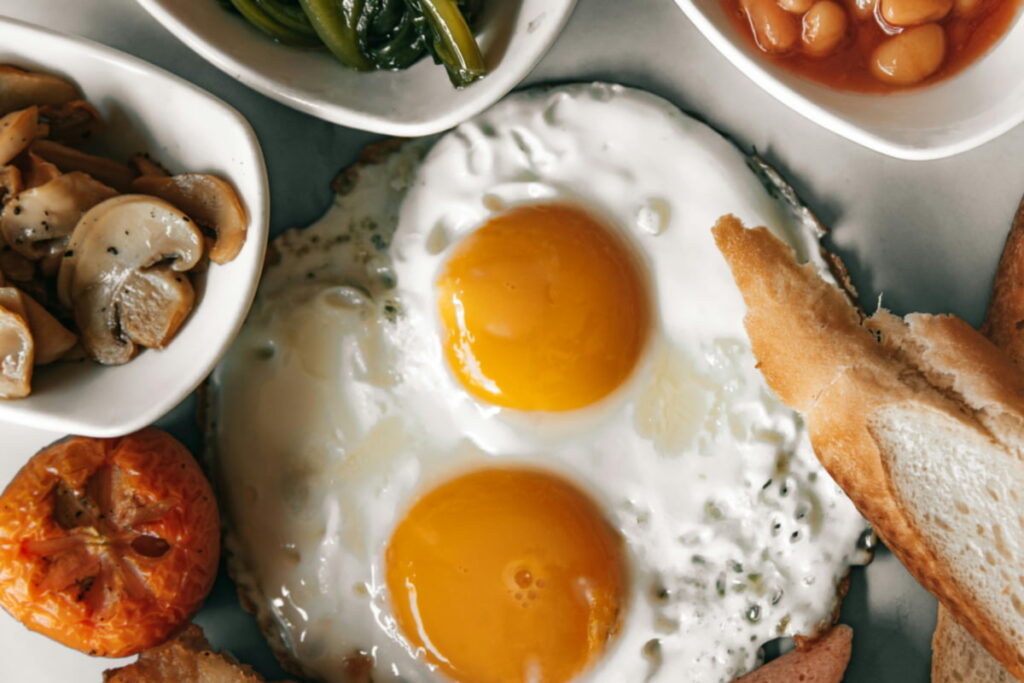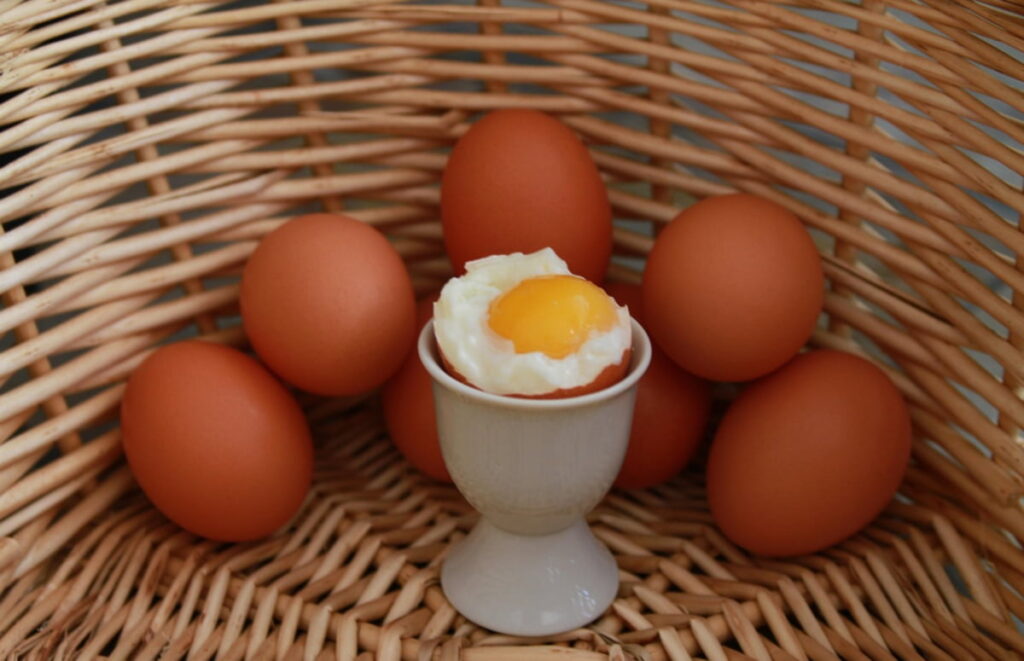
I used to have a complicated relationship with reheating leftover eggs.
Put simply, I got it wrong more times than I got it right.
Rubbery eggs, microwave explosions, and kitchen-smelling sulfur bombs were all part of the learning curve.
But after plenty of trial, error, research, and picking up tips from real chefs, I’ve cracked the code (100% pun intended) on reheating eggs so they come as close as possible to tasting like when you first made them.
I made all the mistakes, so you can skip them. Ready to get it right?
In this guide, you’ll learn:
- How to reheat scrambled, fried, boiled, poached, and baked eggs perfectly
- Which reheating techniques work best (and which to avoid)
- Tips for keeping eggs moist, fluffy, and tasty
Which Egg Are We Rescuing Today?
Should You Reheat Eggs?

Let’s get this out of the way:
Yes, you can reheat eggs, and they can still taste great.
But only if you use the right method, otherwise, prepare for….
Like most foods, eggs change texture when heated. That’s why they often end up rubbery or dry when reheated (we talk about this in the next section).
But, what I’ve learned is that when you reheat them gently and correctly, they can come surprisingly close to how they were fresh.
Safety-wise? Reheating cooked eggs is totally safe — as long as you follow food safety best practices.
According to the FDA, cooked eggs (like scrambled, boiled, or baked) should be:
- Refrigerated within 2 hours
- Eaten within 3–4 days (only 2 days for poached or soft-boiled eggs)
- Reheated to an internal temp of 165°F (74°C)
Source: USDA Food Safety Guidelines
And yes — it’s safe to microwave eggs, as long as they’re not still in the shell.
(Otherwise: 💥💣)
Why Reheated Eggs Turn Rubbery (and Sometimes Smelly)

Before we dive into the how, you need to know what you’re up against.
When you first cook eggs, gentle heat causes the proteins to set just right, trapping moisture and giving you that soft, fluffy texture we all love.
But when you reheat eggs too quickly or with high heat, something called protein denaturation happens.
This means the proteins tighten up even more, squeezing out moisture like a sponge. The result? Dry, rubbery eggs that nobody wants.
And that notorious sulfur smell? That’s from overheating, too.
When egg proteins break down under intense heat, they release sulfur compounds, the cause of the dreaded “rotten egg” smell that can linger in your kitchen (or office microwave).
Now let’s look at how to reheat eggs of all kind.
How to Reheat Each Type of Egg

Reheating eggs isn’t one-size-fits-all. Scrambled eggs need a gentle touch, boiled eggs need steam (not explosions), and poached eggs… well, they need finesse.
Below are the best general methods that I have found work really well. And if you want step-by-step instructions, safety tips, and exact timing, follow the links to each detailed guide.
Scrambled Eggs
Best method: Low heat on the stove with a splash of moisture.
Why it works: Scrambled eggs dry out fast. Gentle heat keeps them soft, not rubbery.
Boiled Eggs
Best method: Hot water soak, not in the microwave (unless you like cleaning egg off your ceiling).
Why it works: This warms the egg evenly without overcooking the yolk or causing explosions.
Fried Eggs
Best method: Covered skillet over low heat.
Why it works: Keeps the yolk intact and the whites tender — without frying them all over again.
Poached Eggs
Best method: Brief dip in hot (not boiling) water.
Why it works: Maintains the delicate texture without turning it into a rubbery mess.
Omelets & Frittatas
Best method: Covered in foil in the oven, or a gentle microwave if you’re in a hurry.
Why it works: Slow, even reheating keeps the inside creamy and the edges from drying out.
What About the Microwave?
If you’re wondering whether you can just microwave your leftover eggs instead of using a pan or hot water, you’re not alone.
Microwaving eggs can be a huge time-saver, but it also comes with risks (like rubbery texture… or worse, egg-splosions 💥).
Here’s what to know before you hit “start.”
Microwave Safety by Egg Type
| Egg Type | Safety Score (1–10) | Notes |
|---|---|---|
| Boiled | 2/10 | Risk of explosion — avoid |
| Scrambled | 8/10 | Use low power and a damp paper towel |
| Fried | 6/10 | Yolk may overcook — use 50% power |
| Poached | 3/10 | Breaks easily — simmer in water instead |
| Omelet/Frittata | 7/10 | Great for slices — go low and slow |
Microwave Best Practices
- Use 50% power to avoid overcooking
- Heat in short bursts (15-30 seconds) and check frequently
- Cover with a damp paper towel for moisture retention
Important Warning: Never microwave whole boiled or poached eggs – they can explode from steam buildup.
FAQs
Can you reheat scrambled eggs the next day?
Yes — if they were stored properly in the fridge within 2 hours of cooking, scrambled eggs can be safely reheated the next day. Use the stovetop for best texture, or microwave at 50% power in short bursts.
Why do reheated eggs smell funny?
A sulfur-like smell happens when eggs are overheated, especially in the microwave. The proteins release sulfur compounds when they’re cooked too long or at too high a temperature. Reheat gently to avoid this.
Can you meal prep eggs for the week?
Absolutely. Scrambled, boiled, and baked egg dishes like frittatas are great for meal prep. Just store them in airtight containers in the fridge and reheat each portion to 165°F before eating.
Are reheated eggs safe for kids?
Yes — as long as the eggs were cooked thoroughly, stored properly, and reheated to 165°F (74°C), they’re safe for kids. Avoid rubbery textures for younger kids who may have difficulty chewing.
What’s the best way to store cooked eggs?
Cool them quickly after cooking and refrigerate within 2 hours. Use airtight containers and keep them at or below 40°F (4°C). Most cooked eggs last 3–4 days in the fridge. Poached eggs are best within 2 days.
Reheatability Scorecard
To end things off, her is a a quick snapshot of what I’ve found with which eggs reheat best and the ideal method to use.
| Egg Type | Reheat Score | Best Method |
|---|---|---|
| Scrambled | 9/10 | Stovetop (low heat) or microwave (50% power) |
| Poached | 8/10 | Gentle simmer in water |
| Boiled (peeled) | 8/10 | Hot water bath |
| Fried | 7/10 | Covered pan on the stovetop |
| Omelet / Frittata | 8/10 | Oven (350°F) or microwave with low power |
Final Takeaway
Reheating eggs doesn’t have to mean destruction.
When you use the right method for each egg type, you can bring your leftovers back to life, safely and deliciously. Whether you’re meal prepping for the week or just hate wasting food, learning to reheat eggs the right way is a small habit that pays off big.
Key Things to Remember:
- Always reheat eggs to 165°F (74°C)
- Never microwave whole boiled or poached eggs
- Use low, even heat — whether it’s the stove, oven, or microwave
- Don’t reheat more than once